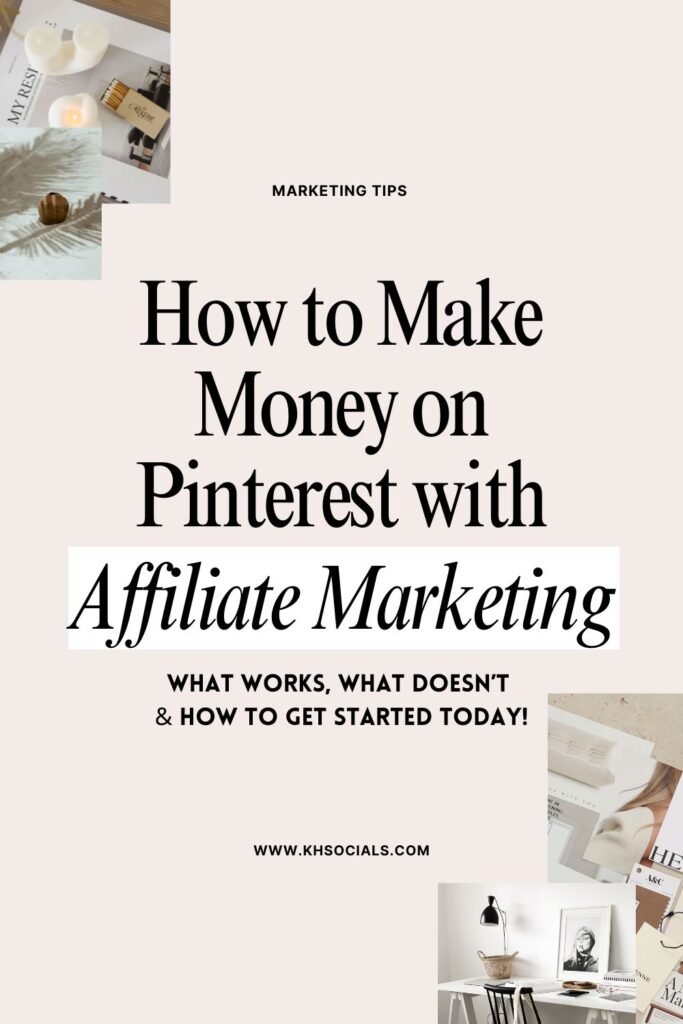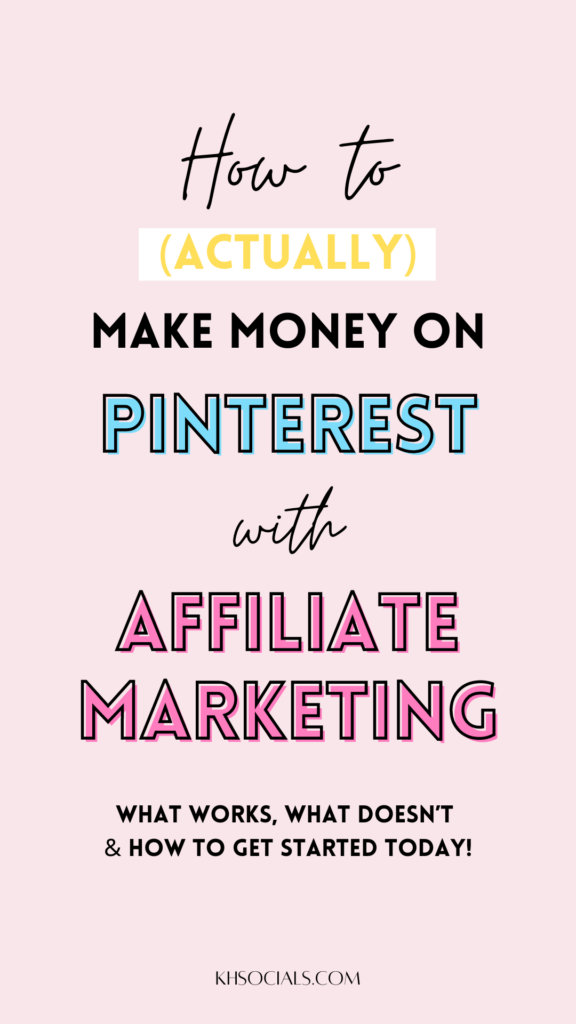Your guide to making money on Pinterest with affiliate sales (the right way!)

Lately, I’ve been seeing a lot of content about how to make money on Pinterest with affiliate links, so I wanted to write a post to clear up some misconceptions and share how to use affiliate links on Pinterest- the right way.
Because yes, you absolutely can use Pinterest marketing to make money with affiliate links, a lot of my clients do it very successfully. BUT, it’s not going to be in the get-rich-quick way that a lot of posts claim is possible.
The two main problems I see people saying (which often go hand in hand) are
- You can make money on Pinterest with affiliate marketing without needing a blog
- You can make money by creating Pins and linking directly to affiliate products.
Neither of these are likely to be profitable and neither help to build a sustainable business or income stream.
Let’s take a closer look. First I’m going to share the technical side of why this approach is ineffective, and then I’ll share why this approach doesn’t work when you consider the Pinterest audience and how people make purchasing decisions.
(ps. you can skip this and scroll down if you don’t really care why this doesn’t work and just want to get to what does work!)
First off, when you have a Pinterest business account, you’re able to “claim” a website. This means that Pinterest understands this is your site, and all of the content Pinned from your site (either by you or another Pinterest user) is tracked in your analytics.
Want more Pinterest marketing tips? Grab my FREE Beginner’s Guide to Pinterest Marketing
Pinterest gives priority to content you Pin from your claimed URL, so pinning to your own site almost always garners better results than pinning from another site.
Affiliate links in particular don’t tend to perform well on Pinterest. Pinterest wants to deliver high value content to its users, not a feed full of spammy affiliate links, so it tends to suppress these types of links in favor of higher value content (i.e. blog posts, galleries, YouTube videos, etc.).
So that’s the logistical side of why this strategy doesn’t work, but we also need to consider the mindset of your audience. Understanding where your Pinterest user is in their sales journey is super important, and we’ll talk more about that in the next section.
Finally, for sustainable growth for your blog or business, you want to send people to your website. Full stop. Everything in your Pinterest strategy should be about getting your Pinterest audience to your website, from where they can then be funnelled towards your intended goal (affiliate sales, email sign ups, etc.).
This is how you grow an audience, build a trusting and engaged community, and creating a platform to which users will continue to return (and shop your affiliate links!). Much better than hoping for a few one off affiliate sales!
Okay, now that that’s out of the way, let’s get to the good stuff.
How to (actually) make money on Pinterest with affiliate marketing
Like we talked about earlier, you will need a website to send your Pinterest audience to, and having a blog is really the best way to make money on Pinterest with affiliate links.
Rather than creating Pins that link directly to your affiliate products, you’ll create Pins to your blog posts, which contain free content of value to your audience, and then link to your various affiliate products throughout the post.
1. Understand your audience
Understanding who your audience is and what their interests, pain points, and questions are will help you create the kind of content they’re looking for.
For example, if you have a style blog and want to link to straight leg jeans, you could create a post on “10 Ways to Style Straight Leg Jeans This Fall”
2. Understand the Pinterest audience
Understanding the mindset and customer journey of a Pinterest audience is also essential to creating a profitable Pinterest affiliate strategy because they operate differently than users on other platforms.
On Pinterest, users are in discovery mode. They’re actively looking for things (ex. meal ideas, wedding inso, fashion tips, home decor, etc.), so we meet them there with answers/inspiration (ex. recipes, wedding dresses or decor ideas, fashion blog posts, home decor tutorials, etc).
Because they’re in discovery mode, they may not be ready to make an immediate purchase. They may save your Pins for later consideration or want to get to know you and your blog first to build up the “like-know-trust” factor before they trust your affiliate recommendations enough to make a purchase.
This does mean the affiliate sales may be a bit more of a long game, but you’re rewarded with a growing audience who trusts what you’re selling.
For example, one of my clients, Style Your Occasion, consistently creates great style content and shares pieces I really love. I trust her taste and style, so I now go to her site when I’m looking for new items because I trust that I’ll like what she’s sharing.
I didn’t purchase from one of her links the first time I saw her site, but now I’m a repeat affiliate shopper.
3. Create high value content
So now that you know who you’re creating content for and how they operate, it’s time to create free content, typically blog posts. You’ll create blog posts with links to your affiliate products that help to build your audience’s trust in you.
4. Capture your audience for repeat visits
The key to successful affiliate sales is building an audience who is going to continue coming back to and shopping your site. There’s a number of different ways to do this including building an email list and encouraging users to follow you on Pinterest, Instagram, TikTok, etc.
Pinterest is a top of funnel marketing platform, so we always want to encourage our Pinterest traffic to take the next step in the sales funnel and keep them coming back again and again.
5. Identify (and lean into) top performing affiliate sales
Keep a close eye on which products continually drive the most clicks and sales and then create more content around these products. For example, if there’s a certain brand that performs well, create some blog posts all around this brand (ex. 5 Must-Have Ugg Boot Styles for 2023). If a certain product performs well, create posts specifically around the product (ex. 10 Ways to Style the Lululemon Align Bike Shorts for Summer).
You can also create a landing page with your top performing affiliate posts, like a “Shop Our Faves” page.
Making great money on Pinterest with affiliate marketing is absolutely possible. It may not be as simple as throwing up some affiliate Pins, but done correctly, it can be an amazing long term revenue stream.
Interested in growing your blog and affiliate sales with Pinterest marketing? Check out my Services page to see how we can work together!
pin it

Hello, thank you for sharing. do you have any tips on how i can find affiliates for my digital product? i have a product about Amazon FBA and i am looking for affiliates to partner with. i tried facebook groups all i got were indians with background. i am looking for a blogger like yourself. Are you opened to starting a new affiliate relationship? If No, can you point me in the right direction?
Thank you
I’m interested in exploring affiliate marketing opportunities by sharing cute wallpapers online. I’d love to monetize my passion for sharing adorable and visually appealing content with others. Can you provide guidance on how to get started with affiliate marketing in the niche of cute wallpapers